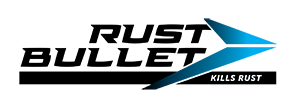Preparing your floor properly is essential for achieving the best results with Rust Bullet Concrete Coatings. Here are the steps you should follow:
1. Clean the Surface
-
- Remove Debris: Sweep or vacuum the floor to remove dust, dirt, and loose debris.
- Degrease: If there are any oil or grease stains, use a degreaser to clean these areas thoroughly. Use a gentle detergent such as dish soap mixed with water and avoid introducing too much water to the surface during cleaning.
2. Repair Any Damage
-
- Cracks and Holes: Fill any cracks or holes with an appropriate concrete repair product, compatible with a moisture cured urethane. Make sure the repair material is fully cured and lightly scuff before proceeding.
3. Ensure a Proper Profile
- Profile Requirements: Rust Bullet requires a Concrete Surface Profile (CSP) of only one (1) for application. This is equivalent to about 120 grit sandpaper in texture. (see image below)
- Adhesion Test: Pour 1oz of water on your floor, if it is absorbed within 30-60 seconds, your floor has an adequate profile. If the water beads up and is not absorbed, you will need to sand to create the appropriate CSP.
- Sand if Needed: If your floor has a smooth finish, it will likely need to be sanded to provide a profile. Rust Bullet does not require diamond grinding or etching of the floor, and typically 80 grit sandpaper on an orbital or pole sander will suffice. If you have a rough or broom finish, you likely have a sufficient CSP.
4. Check for Moisture
- Moisture Test: Perform a moisture test to ensure the floor is dry enough for coating. Tape a piece of plastic to the floor and leave it for 24 hours. Look for condensation on the underside of the plastic sheet or a visible darkening of the slab below the plastic that is damp to the touch. Both are signs of an excessively moist floor.
- Confirm No Moisture: Rust Bullet is a moisture cured urethane and it is imperative for proper adhesion that the surface is completely dry. If you have any signs of moisture, do not apply! Only apply the coating after you have confirmed there is no residual moisture in your floor.
5. Final Cleaning
-
- Vacuum or Sweep Again: Make sure the floor is completely free of dust and debris.
-
- Tack Cloth: For a final touch, use a tack cloth to remove any fine dust particles.
6. Masking and Protection
-
- Mask Off Areas: Use painter’s tape to mask off any areas you do not want to coat, such as walls and baseboards. nnnn
- Protect Adjacent Areas: Cover nearby surfaces with plastic sheeting or drop cloths to protect them from splashes and spills. nnnn
- Wear Proper PPE: It is recommended to wear gloves, protective clothing, protective eyewear, and an organic vapor respirator when working with Rust Bullet.
NOTE: Rust Bullet coatings are permanent after curing, Rust Bullet can only be removed with rigorous abrasive action with a mechanical grinder/sander. Clean up fresh, uncured Rust Bullet immediately by using Rust Bullet Solvent, following the directions on the container. If Rust Bullet gets on skin, wash with soap and water immediately.
7. Ensure Proper Ventilation
- Ventilation: Make sure the area is well-ventilated during application and curing. Open windows and doors or use fans to promote air circulation. Be cautious when circulating air as this can increase the risk of particles coming into contact with the coating while drying, and becoming permanently stuck in the cured coating.
Once these steps are completed, your floor will be properly prepared for applying Rust Bullet Concrete Coatings. Following these preparation steps carefully will help ensure a smooth, durable, and long-lasting finish.

